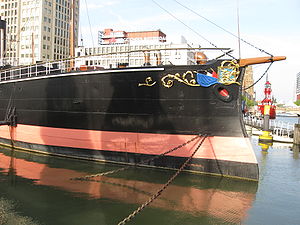Zr. Ms. Buffel
|
|
|
|---|---|

|
|
| Ship data | |
| Ship type | Monitor ironclad with ram post |
| Ship class | Ironclad |
| Keel laying : | June 10, 1867 |
| Launch: | March 10, 1868 |
| Commissioning: | July 23, 1868 |
| Builder: | Robert Napier & Sons, Glasgow, Scotland |
| Crew: | 117 |
| Technical specifications | |
| Measurement: | 2198 GRT |
| Displacement : | 2,261 t |
| Length over all: | 62.70 m |
| Length between perpendiculars: | 59.40 m |
| Width: | 12.30 m |
| Draft : | 4.8 m |
| Machinery: | 2 × compound steam engine on 2 × fixed propeller |
| Power: | 2200 hp |
| Speed: | 12 knots |
| Whereabouts | |
| Museum ship in Hellevoetsleus | |
His Majesty's second-class armored, tower, and ramming ship, the Buffel , was the full name at the time, a monitor ironclad with a ramming stem located in Hellevoetsluis , which was operated as a stationary museum ship of the Maritime Museum Rotterdam until 2013 .
history
The iron ship, built in 1868 in Govan , Glasgow as hull number 139 by the shipyard Robert Napier & Sons , was put into service on July 23, 1868 as a coastal defense ship of the Royal Netherlands Navy.
The Buffel (HW 12) was the lead ship of a series of three ( Buffel , Schorpioen and Stier ) built by several shipyards between 1867 and 1869 of ironclad ships with a monitor ( gun turret ) and ram post. The ram post was installed as a weapon, especially in view of the large numbers of wooden ships of other navies that were still in existence at the time. The rotating turret served as a weapon against other modern ironclad ships.
During its seventeen years of service in the Dutch Navy, the ship never got into combat. After it was hung up, the Buffel was dismantled in 1894 and used as a residential ship from 1896 , initially in Hellevoetsluis and later in Den Helder . Then she was used as a training ship for the Amsterdam naval shipyard, where she survived the Second World War . Their future NATO - Ship identification was A884. In 1973 the Buffel was finally decommissioned and sold to the city of Rotterdam in 1974. In the following years it was restored to its original state and from 1979 to 2013 it was in Leuvehaven as part of the Maritime Museum Rotterdam not far from the Erasmus Bridge. In 2013 she was brought to Hellevoetsluis to serve as a museum ship. It remains the property of the city of Rotterdam, but fell out of the museum's care. According to a museum guide dated June 16, 2018, the ship has now become the property of a volunteer community that maintains and operates it. Tickets are sold for this and the ship is rented out for events.
The Buffel armament originally consisted of two 9.2-inch cannons (muzzle-loaders), four 30-pounder cannons and the ram stem. Due to the long loading times, the muzzle-loaders were quickly replaced by a Krupp cannon (breech-loader), which had a higher rate of fire. A replica of the turret with the two muzzle loaders was attached when the ship was dismantled. The tower cannot be rotated, however, because the access stairs installed subsequently lead to the lower deck underneath.
Individual evidence
- ^ Press report from November 16, 2012 by the museum; visited on October 27, 2013
literature
- Heine, William C .: Veterans of the seafaring . The most important ships in the world and their history. Stalling Verlag, Oldenburg 1979, ISBN 3-7979-1506-3 .
Web links
Coordinates: 51 ° 49 ′ 44 " N , 4 ° 7 ′ 43.4" E